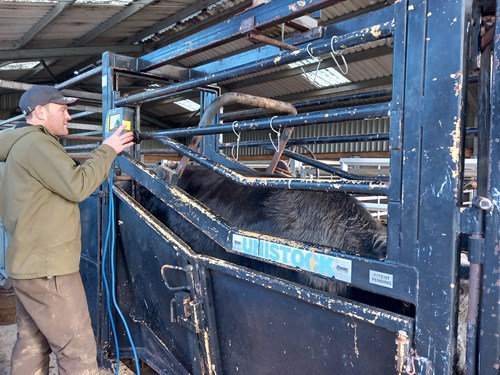The Power of Data to Improve Efficiency in Suckler Herds

The value of weight data to drive management decisions and improve herd efficiency should not be underestimated. With Electronic Identification (EID) in cattle fast approaching, the opportunities from technology to make data capture and interpretation easier will be worth investing in. As part of the Scottish Government’s Farming for a Better Climate Programme two suckler beef producers in Perthshire (Andrew Houstoun of Glenkilrie Farm and Iain Wilkinson of Balgay Farm) were keen to take their cattle weighing systems to the next level and received funding to invest in technology to improve the automation of weight data capture.
Cow efficiency
The keys areas that both farmers were keen to investigate further were mature cow size and cow efficiency. Cow efficiency is a measure of what percentage of body weight a cow weans (with the calf weaning weight adjusted to 200 days):
Cow efficiency = (200-day calf weaning weight /cow weight at weaning) x 100
The industry target is for a cow to wean a minimum of 45% of her body weight. This equation must be used with caution though, as it favours the later born calf i.e. their birth weight will make up a greater proportion of their 200-day weight, so their 200-day weight will likely be heavier than a calf born at the start of the calving season, assuming they have similar birth weights and growth rates.
In addition, the mother of the later born calf will then have a higher cow efficiency percentage (assuming she is the same weight as the cow that calved early in the season), but may not necessarily be as fertile, having calved much later. A more accurate calculation would be to take birth weight into account. i.e. work out the calves’ daily liveweight gain from birth to weaning and then adjust to 200 days.
On-farm results
The range in cow weights within the herds was surprising, with both herds showing over a 400kg difference between the heaviest and lightest cow. While cow weight will be partly related to body condition score, one body condition score unit accounts for around 13% of liveweight, which for a 700kg cow is just 91kg. Assuming a 400kg difference in these cows and the same body condition score, the bigger cow needs an additional 40MJ of energy or 11kg silage/cow (at 30% dry matter and 11ME) just to maintain herself. This additional energy is also equivalent to 3.6kg of dried barley. By reducing mature cow size there is the opportunity to carry more cows on the farm and produce more beef off the same inputs or reduce stress in the system if the farm is tight for land/forage supplies and housing space.
Farm data showed that the heaviest cows tended to have poor cow efficiency figures, with the lightest cows weaning a significantly higher percentage of their body weight. At Glenkilrie, the most efficient cows were on average 223kg lighter, yet weaned a calf on average 60kg heavier (see table 1). Remember, the biggest determinant of calf growth is milk intake, and a larger cow doesn’t necessarily produce more milk.

Table 1. Data from Glenkilrie Farm comparing the 10 most efficient and 10 least efficient cows.
Replacement heifers
Weight data is valuable for selecting heifers as replacements. You don’t necessarily always want to select the biggest heifers, as that can potentially increase mature cow size over time. Weaning weight and when they were born in the calving season should also be taken into consideration. Heifer selection should also be based on dam efficiency measures i.e. deciding not to breed a heifer if her dam is for example over 800kg or she consistently has had a cow efficiency measure of 35% or less. These measures should be used in addition to the usual dealbreakers such as selecting against heifers born from cows with bad temperament, calving difficulties and long calving intervals.
Don’t forget the bull!
The bull is half the herd. Analysing weight data of growing and finishing cattle, along with slaughter data, allows you to look at which bulls leave the fastest growing animals, or those with better carcase characteristics. It can also help identify what bulls produce the milkiest mothers based on calf growth rates. While Estimated Breeding Values (EBV’s) do provide this kind of data, they should be used in conjunction with your own herd’s performance data and can help drive further efficiencies such as reducing age at slaughter and improving herd fertility – even more critical now with the Scottish Government’s 410-day calving interval target.

How do you go about reducing mature cow size? Its not an easy thing to do but the following tips may help:
- Avoid simply selecting heifer replacements based on the largest heifers. Consider size in relation in age.
- Avoid selecting heifers for replacements from the largest/heaviest cows in the herd.
- Consider the Mature Cow Weight EBV.
- If breeding heifer replacements avoid bulls with very high EBV’s for 400-day weight.
- Calculate efficiency for your cows annually.
- Aim for a tighter calving pattern to allow more accurate efficiency comparisons.
A tighter calving period increases the number of heifer calves born earlier which are more likely to be a suitable weight for bulling to calve at two years of age.
For more information on the farms involved in this study, take a look at the following case studies:
- www.fas.scot/downloads/glenkilrie-data-collection
- www.fas.scot/downloads/ffbc-cs-balgay-farm-data-collection
Lorna MacPherson, Dairy Specialist, Lorna.Macpherson@sac.co.uk

Unearthed is the exclusive SAC Consulting members' monthly newsletter. Unearthed offers insights and tips from our experts on what we think is in store for farming and crofting in the coming months in order to protect and enhance your business.
Posted by Unearthed News on 13/12/2024
